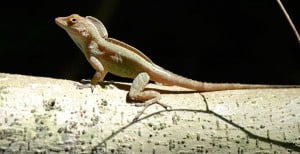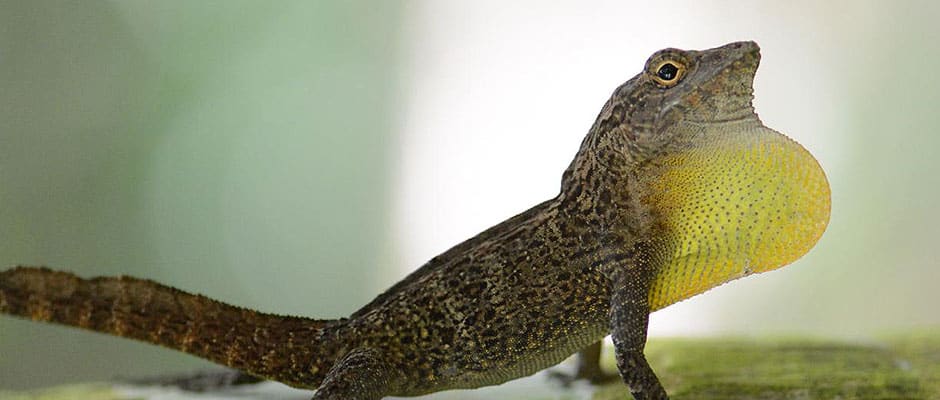Share this article
Lizard Activity Can Act as “Barometer” to Environmental Change
Cold-blooded lizards can be notoriously finicky over the weather, so much so that tracking the activity of certain species could give researchers a way to measure environmental change, according to a new study.
“Behavior really matters. It’s a big component of what animals do. We’re trying to predict how climate, or temperature change, will impact their behavior,” said Manuel Leal, an associate professor of biological sciences at the University of Missouri and a lead author of the study released last week in American Naturalist.

Researcher Manual Leal found that when it gets too hot or too cold, critical activity levels slow down in the crested anole, limiting its ability to cope with climate variability.
Image Credit: Manuel Leal
Leal and a coauthor studied crested anoles (Anolis cristatellus) in Puerto Rico in order to see the kind of activity levels they exhibited under different temperatures. They chose sites and tested the temperature by placing copper models of the lizards then testing their heat since other studies showed the material absorbed the same degree of heat as the lizards. They then watched close to 200 individual lizards for 15-minute stretches, clicking on a special smartphone application to record activities like eating, mating, walking around or doing nothing.
They found that the lizards were most active between 81 and 84 degrees, winding down above and below those numbers.
“When an animal is active, it can be looking for mates, reproducing. Activity level is very important for allowing a species to survive,” Leal said. “If they are not active they will not be able to eat or reproduce.”
But in a second phase of the study, the researchers wanted to see if anoles actually lacked the energy to move around outside that optimal temperature range, or whether it was just a case of lizard laziness.

Puerto Rican crested anoles lower their activity levels with temperatures about or below their range of comfort, even if they still have the energy to move quickly, according to a new study.
They kept anoles kept in incubators at fixed temperatures then put them on a special 6.5-foot racetrack they built. As seen on a video on Leal’s blog (complete with a Ghostface Killah soundtrack), a tap on the tail prompted the reptiles “to take off” across the racetrack, which the researchers timed. Leal and his co-researcher found that anoles could actually maintain optimal speeds at a larger temperature window than initially believed.
“Lizards will dial down their activity at temperatures at which they still move relatively fast,” Leal said, meaning the lizards choose not to move fast even though they can. But while he couldn’t say for sure why they did this, he speculated that it could be to conserve energy.
This higher adaptability to warmer or colder temperatures is good news for the anoles, since it means that they might be able to cope with warmer temperatures in the future. “One potential is that they might be able to actually behaviorally deal with to deal with this change.”
Another study last year in Science showed that anoles may have the ability to evolve quickly — sometimes within a matter of 15 years. The Carolina anole (Anolis carolinensis) has been able to adapt to living higher up in trees due to being pushed off ground habitats in the Southeast United States by the invasive brown anole(Anolis sagrei) from Cuba.
But regardless of their ability to adapt or evolve, Leal said that the way animal behavior changes should be taken into account when assessing risks to species from climate change. “The window of activity is going to matter a lot,” he said. “Behavior might be more sensitive than you think”
The video above, unrelated to the recent study, shows how anoles adapted to exploit different ecosystem niches in Cuba. Credit: Tom Rowland via Youtube.
Header Image:
A male crested anole. A new study reveals the crested anole is active over a broader range of temperatures than scientists had previously observed.
Image Credit: Manuel Leal








